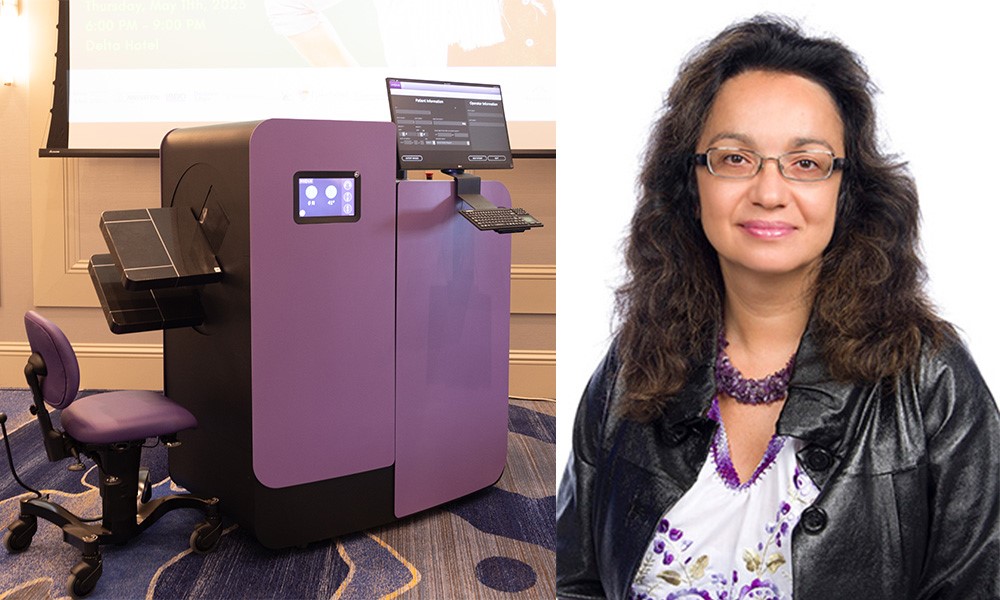Thunder Bay 50/50 Draw Helps Fund Homegrown Mammography Alternative… and That’s Just the Beginning
by Graham Strong
 The Radialis Unit (left) was researched, developed, and manufactured right here in Thunder Bay. Dr. Alla Reznik (right) led the research team that developed the technology for the Unit.
The Radialis Unit (left) was researched, developed, and manufactured right here in Thunder Bay. Dr. Alla Reznik (right) led the research team that developed the technology for the Unit.The Thunder Bay 50/50 Draw provides funding for local and regional healthcare. It has helped fund something extra special: a new mammography alternative researched, developed, and manufactured right here in Thunder Bay. Proceeds from Thunder Bay 5050 ticket sales have and will go directly to improve Regional Breast Cancer Care such as the purchase of a Radialis unit, only the third one to be installed in the world after Princess Margaret Cancer Centre in Toronto and the University of Pittsburgh Medical Center.
The new molecular breast imaging technology using positron-emission tomography (PET) provides an alternative way to find breast cancer, especially for women with dense breast tissue. And, because it does not use breast compression like traditional mammography, it is painless.
“The beauty of Radialis is that it reveals cancerous tumours that would be hidden in normal mammography,” Dr. Alla Reznik said. During a CBC interview, she told of a patient who had a tumour near a scar of a previous breast cancer. It got missed during mammography because the scar tissue hid the tumour. When they used molecular breast imaging to image the same area, the tumour appeared clearly.
Similarly, women with dense breast tissue are at risk of having their cancer missed because tumours remain hidden using traditional X-ray mammography. The reason Radialis works so well is that it uses radioactive glucose (sugar) tracers. Cancerous cells absorb the sugar tracer along with the small bits of radioactive material attached to it. That “lights up” the tumours during a scan so that cancerous tumours are easily detected, regardless of the tissue around it. These tracers are made at our cyclotron on Oliver Road.
Radialis is another screening tool, but it won’t replace traditional mammography, Dr. Reznik said.
“Mammography is still the Gold Standard for breast cancer screening, and no doubt it saves lives. For women with entirely fatty breasts, X-ray mammography works extremely well. But that’s only half the female population,” Dr. Reznik said.
She added that for women with heterogeneous dense breast tissue – alternating areas of dense and fatty tissue – women are more likely to have “suspicious” results. That means further testing to determine if there is a cancerous tumour present.
Traditionally, that testing involves breast biopsy – long, thick needles to get a sample for testing. If that’s not bad enough, the suspicious area can be difficult to reach and may require the test to be repeated more than once. Not only is this long and painful, it puts women into what one of the patients calls “Maybeland” where they are left to worry about whether or not they have breast cancer for weeks or months at a time.
“Radialis can help women avoid this Maybeland,” Dr. Reznik said. “It’s a fast, more conclusive test without the wait or the pains of breast compression during traditional x-ray mammography and a core biopsy.”
The Radialis unit can also be used for other medical indications both in diagnosis and treatment. Other uses include prostate, pancreatic, and head-and-neck cancers as well as neurology, rheumatology, and cardiology. And that’s just the beginning.
“We can use Radialis for neurodegenerative diseases, differentiating between different types of dementia and even detect early onset Alzheimer’s disease,” Dr. Reznik said.
There is still time to buy your tickets and help bring this remarkable, homegrown technology to our Hospital! Find out what the jackpot is at right now and get your tickets at: https://www.healthsciencesfoundation.ca/5050